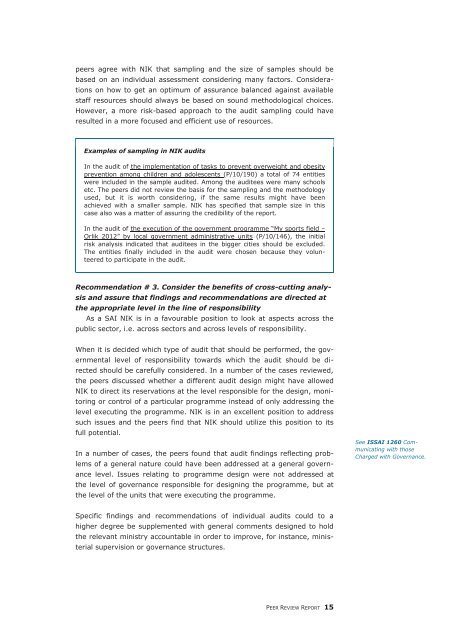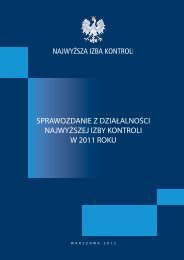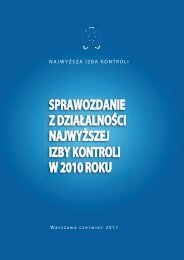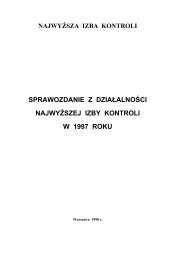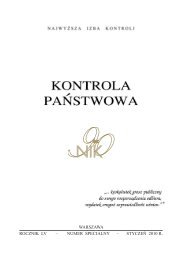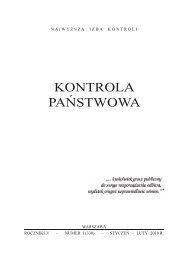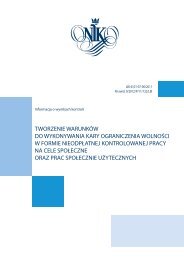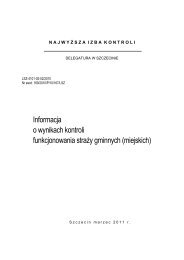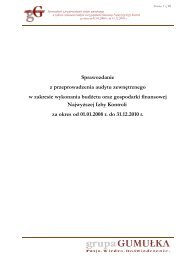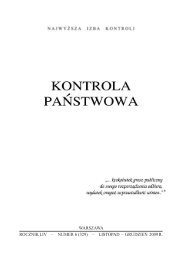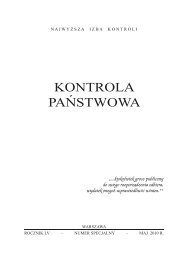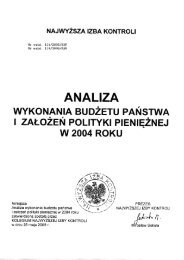NIK peer review report - Najwyższa Izba Kontroli
NIK peer review report - Najwyższa Izba Kontroli
NIK peer review report - Najwyższa Izba Kontroli
Create successful ePaper yourself
Turn your PDF publications into a flip-book with our unique Google optimized e-Paper software.
<strong>peer</strong>s agree with <strong>NIK</strong> that sampling and the size of samples should bebased on an individual assessment considering many factors. Considerationson how to get an optimum of assurance balanced against availablestaff resources should always be based on sound methodological choices.However, a more risk-based approach to the audit sampling could haveresulted in a more focused and efficient use of resources.Examples of sampling in <strong>NIK</strong> auditsIn the audit of the implementation of tasks to prevent overweight and obesityprevention among children and adolescents (P/10/190) a total of 74 entitieswere included in the sample audited. Among the auditees were many schoolsetc. The <strong>peer</strong>s did not <strong>review</strong> the basis for the sampling and the methodologyused, but it is worth considering, if the same results might have beenachieved with a smaller sample. <strong>NIK</strong> has specified that sample size in thiscase also was a matter of assuring the credibility of the <strong>report</strong>.In the audit of the execution of the government programme “My sports field –Orlik 2012” by local government administrative units (P/10/146), the initialrisk analysis indicated that auditees in the bigger cities should be excluded.The entities finally included in the audit were chosen because they volunteeredto participate in the audit.Recommendation # 3. Consider the benefits of cross-cutting analysisand assure that findings and recommendations are directed atthe appropriate level in the line of responsibilityAs a SAI <strong>NIK</strong> is in a favourable position to look at aspects across thepublic sector, i.e. across sectors and across levels of responsibility.When it is decided which type of audit that should be performed, the governmentallevel of responsibility towards which the audit should be directedshould be carefully considered. In a number of the cases <strong>review</strong>ed,the <strong>peer</strong>s discussed whether a different audit design might have allowed<strong>NIK</strong> to direct its reservations at the level responsible for the design, monitoringor control of a particular programme instead of only addressing thelevel executing the programme. <strong>NIK</strong> is in an excellent position to addresssuch issues and the <strong>peer</strong>s find that <strong>NIK</strong> should utilize this position to itsfull potential.In a number of cases, the <strong>peer</strong>s found that audit findings reflecting problemsof a general nature could have been addressed at a general governancelevel. Issues relating to programme design were not addressed atthe level of governance responsible for designing the programme, but atthe level of the units that were executing the programme.See ISSAI 1260 Communicatingwith thoseCharged with Governance.Specific findings and recommendations of individual audits could to ahigher degree be supplemented with general comments designed to holdthe relevant ministry accountable in order to improve, for instance, ministerialsupervision or governance structures.PEER REVIEW REPORT 15


